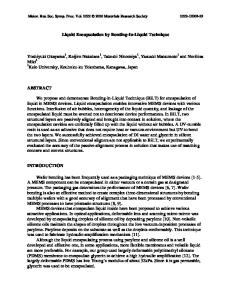Sb bonding in GeSbTe compounds by NMR Measurements
- PDF / 135,910 Bytes
- 6 Pages / 612 x 792 pts (letter) Page_size
- 102 Downloads / 305 Views
1072-G02-06
Sb bonding in GeSbTe compounds by NMR Measurements David C. Bobela1, and P. Craig Taylor2 1 Dept of Physics, University of Utah, Salt Lake City, UT, 84112 2 Dept of Physics, Colorado School of Mines, Golden, CO, 84112
INTRODUCTION A structural model for the amorphous phase of Ge-Sb-Te (GST) systems, most notably the composition Ge2Sb2Te5, has been the topic of controversy for several years. Recent extended x-ray fine structure (EXAFS) experiments in some GST materials has led to two very different pictures of the amorphous phase, but neither of the two has proven conclusive based upon the EXAFS data alone [1, 2]. Recently, nuclear magnetic resonance (NMR) experiments have been performed to supplement the structural information gathered from EXAFS. Results for the Te atom demonstrated the existence of two chemically different Te sites in the as-deposited amorphous phase Ge2Sb2Te5 [3]. However, due to the lack of NMR studies on electronically similar telluric compounds, the particular coordination of the Te sites in the amorphous Ge2Sb2Te5 relied on the EXAFS results, which are subject to upwards of 30% error. The NMR literature for compounds containing Sb is substantial and provides a nice backdrop to which the emerging data for GST materials can be compared. Therefore, we have performed NMR experiments on the 121Sb nucleus in order to probe the coordination and bonding symmetries at the Sb site. The 121Sb NMR data are particularly sensitive to electric field gradients at the nuclear site, due to the immediate electronic cloud. When the asymmetric nuclear charge interacts with the electric field gradient, the magnitude and asymmetry of the electric field gradient are encoded in the width of the central transition of the frequency space spectra for 121 Sb via the relation v q2 6 2 ∆( ppm) = 3200 ×10 (η + 22η + 25) 2 , (1) vL where vq is the magnitude of the interaction (coupling constant) in MHz, η is a measure of the departure from an axially symmetric field gradient (0 ≤ η ≤ 1), and vL is the resonant frequency of Sb in the applied magnetic field in MHz [4]. The units of ∆ are in parts per million (ppm), which is a convenient scale that removes interactions linear in the applied field (see Eq. 2 for definition). For reference, η = 0 for cases where the Sb nucleus is bonded in a perfectly octahedral configuration. In the remainder of this paper, we present the NMR spectra of crystalline Sb2Te3 (cSbTe), Ge1Sb2Te4, Ge2Sb2Te4, and Ge2Sb2Te5 (denoted collectively as GST herein unless otherwise noted) and analyze the spectra with regards to Eq. 1. The coupling constants are then compared with values measured for other compounds containing Sb in a variety of bonding configurations. METHODS AND SAMPLE SYNTHESIS The NMR experiments were performed at approximately 6.28 Tesla. using a broadband Tecmag NMRkit-II spectrometer integrated with a Tecmag Aries digitizer unit. The hardware is controlled using MacNMR version 5.0 software. The magnetic field was verified to within
approximately 10 Hz by measuring the de
Data Loading...










